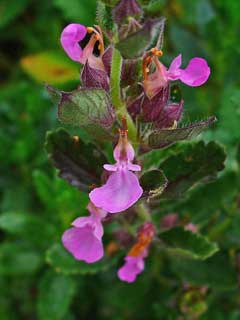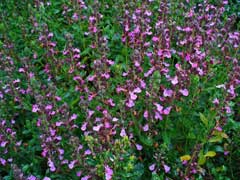 |
|
http://commons.wikimedia.org/wiki/User:Llez |
 |
| http://commons.wikimedia.org/wiki/User:Llez |
Translate this page:
Summary
Bloom Color: Purple. Main Bloom Time: Early summer, Late summer, Mid summer. Form: Upright or erect.
Physical Characteristics

 Teucrium chamaedrys is an evergreen Shrub growing to 0.3 m (1ft) by 0.3 m (1ft in) at a slow rate.
Teucrium chamaedrys is an evergreen Shrub growing to 0.3 m (1ft) by 0.3 m (1ft in) at a slow rate.
See above for USDA hardiness. It is hardy to UK zone 5 and is not frost tender. It is in leaf all year, in flower from July to September, and the seeds ripen from August to September. The species is hermaphrodite (has both male and female organs) and is pollinated by Bees. The plant is self-fertile.
It is noted for attracting wildlife.
Suitable for: light (sandy), medium (loamy) and heavy (clay) soils and prefers well-drained soil. Suitable pH: mildly acid, neutral and basic (mildly alkaline) soils and can grow in very alkaline soils.
It can grow in semi-shade (light woodland) or no shade. It prefers dry or moist soil.
UK Hardiness Map
US Hardiness Map
Synonyms
T. officinalis.
Plant Habitats
Ground Cover; Hedge; East Wall. In. South Wall. In. West Wall. In.
Edible Uses
The plant is widely used in making alcoholic drinks with a bitter base, which have digestive or appetite-promoting qualities[7].
References More on Edible Uses
Medicinal Uses
Plants For A Future can not take any responsibility for any adverse effects from the use of plants. Always seek advice from a professional before using a plant medicinally.
Antiinflammatory Antirheumatic Aperient Aromatic Astringent Bitter Carminative Diaphoretic
Digestive Diuretic Stimulant Tonic
Wall germander is a specific for the treatment of gout[4], it is also used for its diuretic properties, and as a treatment for weak stomachs and lack of appetite[9]. It has also been taken as an aid to weight loss and is a common ingredient in tonic wines[254]. Some caution is advised when using this plant internally, it can cause liver damage[238] The whole herb is anti-inflammatory, antirheumatic, aperient, aromatic, astringent, bitter, carminative, diaphoretic, digestive, diuretic, stimulant and tonic[4, 7, 9, 46, 165, 240]. It is harvested in the summer and can be dried for later use[4, 254]. It is used externally as an astringent infusion on the gums and also in the treatment of wounds[7].
References More on Medicinal Uses
The Bookshop: Edible Plant Books
Our Latest books on Perennial Plants For Food Forests and Permaculture Gardens in paperback or digital formats.

Edible Tropical Plants
Food Forest Plants for Hotter Conditions: 250+ Plants For Tropical Food Forests & Permaculture Gardens.
More

Edible Temperate Plants
Plants for Your Food Forest: 500 Plants for Temperate Food Forests & Permaculture Gardens.
More

More Books
PFAF have eight books available in paperback and digital formats. Browse the shop for more information.
Shop Now
Other Uses
References More on Other Uses
Cultivation details
Landscape Uses:Border, Container, Ground cover, Hedge, Rock garden. Succeeds in any moderately good soil in sun or light shade[31]. Prefers a dry calcareous soil and a sunny position[7, 9]. A very hardy plant, tolerating temperatures down to at least -29°c[238]. Wall germander was at one time widely cultivated as a medicinal plant, though it is seldom use at present[4]. It is a very ornamental plant, making a good edging for the border and able to be lightly clipped[200]. The fresh leaves are bitter and pungent to the taste, when rubbed they emit a strong odour somewhat resembling garlic[4]. This species is often confused in gardens with T. divaricatum and T. x lucidrys. It is important to ensure that you have the correct plant if using it medicinally[238]. Cut off dead flower spikes when the plant has finished flowering in order to encourage bushy new growth[238]. A good bee plant[31]. Plants in this genus are notably resistant to honey fungus[200]. Special Features:Attractive foliage, Fragrant foliage, Not North American native, Attracts butterflies.
References Carbon Farming Information and Carbon Sequestration Information
Temperature Converter
Type a value in the Celsius field to convert the value to Fahrenheit:
Fahrenheit:
The PFAF Bookshop
Plants For A Future have a number of books available in paperback and digital form. Book titles include Edible Plants, Edible Perennials, Edible Trees,Edible Shrubs, Woodland Gardening, and Temperate Food Forest Plants. Our new book is Food Forest Plants For Hotter Conditions (Tropical and Sub-Tropical).
Shop Now
Plant Propagation
Seed - sow spring in a cold frame and only just cover the seed[113]. Prick out the seedlings into individual pots when they are large enough to handle and plant them out in the summer if they are large enough. Otherwise, grow them on in a cold frame for the winter and plant them out in the following spring. Division in early spring[1]. Larger divisions can be planted out direct into their permanent positions. We have found that it is best to pot up smaller divisions and grow them on in light shade in a greenhouse or cold frame until they are growing away well. Plant them out in the summer or the following spring. Cuttings of half-ripe wood, July/August in a frame[113].
Other Names
If available other names are mentioned here
Native Range
TEMPERATE ASIA: Iran (north), Syria, Turkey, Russian Federation-Ciscaucasia (Ciscaucasia), Armenia, Turkmenistan EUROPE: Czechoslovakia, Austria, Belgium, Switzerland, Germany, Hungary, Netherlands, Poland (south), Moldova, Ukraine (incl. Krym), Former Yugoslavia, Albania, Bulgaria, Greece, Italy (incl. Sardinia, Sicily), Romania, Spain (incl. Baleares), France (incl. Corsica), Portugal AFRICA: Algeria (north), Morocco, Tunisia
Weed Potential
Right plant wrong place. We are currently updating this section.
Please note that a plant may be invasive in one area but may not in your area so it's worth checking.
Conservation Status
IUCN Red List of Threatened Plants Status :

Growth: S = slow M = medium F = fast. Soil: L = light (sandy) M = medium H = heavy (clay). pH: A = acid N = neutral B = basic (alkaline). Shade: F = full shade S = semi-shade N = no shade. Moisture: D = dry M = Moist We = wet Wa = water.
Now available:
Food Forest Plants for Mediterranean Conditions
350+ Perennial Plants For Mediterranean and Drier Food Forests and Permaculture Gardens.
[Paperback and eBook]
This is the third in Plants For A Future's series of plant guides for food forests tailored to
specific climate zones. Following volumes on temperate and tropical ecosystems, this book focuses
on species suited to Mediterranean conditions—regions with hot, dry summers and cool, wet winters,
often facing the added challenge of climate change.
Read More
Expert comment
Author
L.
Botanical References
11200
Links / References
For a list of references used on this page please go here
Readers comment